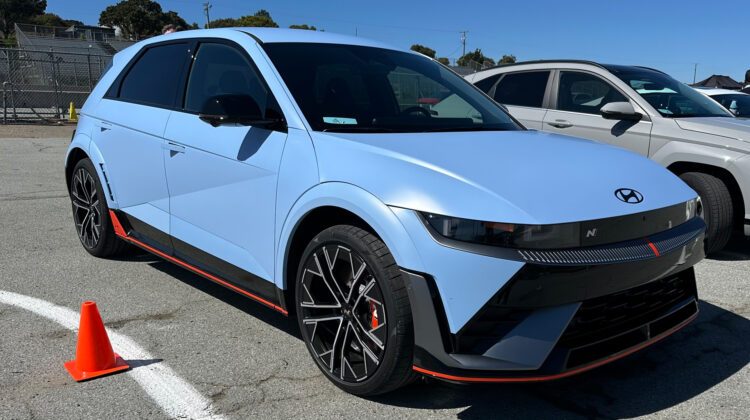
Hyundai IONIQ 5 N
by John McElroy
Somebody had to be first. So Hyundai jumped at the opportunity, and with the Ioniq 5 N, it created the industry’s first all-electric hot hatch. The result is one intriguing car.
Everyone knows that EVs can be wicked fast in a straight line. But they’re heavy, like 4,861 pounds worth of heavy in this case. And that kind of heavy is the enemy of good handling. So Hyundai took the civilian version of the Ioniq 5 and bolted on a bunch of bits to make it handle well enough to earn an N merit badge.
N, of course, is Hyundai’s performance brand. And that letter will not go on a Hyundai unless it can truly appeal to enthusiasts. I’m pretty sure the Ioniq 5 N will attract the attention of a lot of enthusiasts, but we’ll have to wait and see how many will actually pull the trigger and buy one.
For one thing, it’s expensive, $67,475 including destination charges. That’s about $35,000 more than a VW Golf GTI or $22,000 more than a Honda Civic R.
For another, it’s electric. And that brings certain limitations in terms of driving range and heat—as in heat of the battery, motor and power electronics when pushed it to the limit. Hyundai says the Ioniq 5 N can do two laps at the Nürburgring Nordschleife, the historic 13-mile long race track in Germany. And while two laps doesn’t sound very impressive, Hyundai says most electrics can barely do one lap there before everything starts to overheat and shut down.
In other words, the Ioniq 5 N will be well suited for autocrossing, where competitors generally get about 4-5 runs per event, with each run lasting well under a minute. And it might be good for open track days, where drivers generally run three 20-minute sessions, with time in between to do some recharging.
But the Ioniq 5 N probably won’t work for most club racers for two reasons. Unless they have access to a Level 3 charger near the track, they’re not going to have time to recharge the battery between races during the weekend. And many regional tracks do not allow EVs to race because they don’t have the equipment to put out a battery fire, in the rare event that were ever to happen.
So Hyundai is launching a cup series of its own for the Ioniq 5 N that is getting underway right now in South Korea. The cars, which are Ioniq 5 Ns fitted with a roll cage, slicks and other safety equipment, cost about $80,000. Hyundai is installing 350 kW Level 3 chargers at the tracks where the cup series will run, and they can take a 10% charge up to 80% in 18 minutes. The cup racers also get 5 years of free charging at the track. Ten teams have already signed up for the series and if all goes well, Hyundai wants to take it to other markets around the world.
That will certainly shine a spotlight on the track version of the car, but the street version has some bragging rights of its own. First off, here’s the numbers everyone will be taking about: 601 horsepower and 545-pound feet of torque. That’s 281 more hp and 99 more lb-ft than the non-N version of the AWD Ioniq 5. And there’s a push-to-pass button on the steering wheel that adds another 40 hp for 10 seconds. That’s a lot of oomph and the acceleration of this car is impressive.
To improve the handling, they lowered the ride height half an inch, and the driver’s seat by 1.6 inches. They added more aero bits, including active aero flaps on the front end and a larger rear spoiler and bigger diffuser. The car sits on big 275/35R21 Pirelli P Zero summer tires that Pirelli says will last for 25,000 kilometers, or about 15,500 miles. That’s not exactly a sparkling number, but Pirelli says it’s actually decent for a +600 hp car. Pirelli is also developing an all-season tire and a street-legal track tire for the car.
Other notable changes from the street version: torsional rigidity was improved 11% by adding 42 spot welds to the body. There is separate cooling for the motor and battery. The power density of the 84 kWh battery is 78.5 watt hours per pound, versus the 72.8 Wh/lb on the civilian versions of the Ioniq 5. That gets you 221 miles of EPA rated driving range, compared to the non-N AWD version’s 260 miles from a 77.4 kWh battery. So, you get a bigger battery and more power density, but you lose range. Sorry. You want gobs of power? You’re going to have to make some compromises.
Make no mistake, this N truly feels like a car for the track. The seat is snug. The steering is precise. The ride is very stiff. You feel every little bump and ripple as it rumbles down the road. It’s got the rough and ready feel of any other hot hatch, and it sounds like one, too.
Hyundai knows that electrics lack the visceral sounds and feedback of a piston engine. And so it adds them. Drivers can choose from three sound signatures: one that mimics the company’s 2-liter turbo, one that mimics the sound track of the Hyundai Vision concept car from the Gran Turismo sim game, and one that mimics a fighter jet. For me, the 2-liter turbo was the most pleasing and realistic.
Even crazier, Hyundai added what is calls e-shift, which mimics the shift points of a transmission, by shifting with the steering wheel paddles. You can even blip the throttle when it’s in neutral, and it “rev matches” when downshifting into corners. It even comes with a redline, and if you bump up against the mythical 6,000 rpm limit, the motor chokes and stumbles just like a piston engine would until you upshift.
I’m sure that on paper all this sounds kind of hokey, and some of it is. But out on the track, the feedback from the sound actually gives you a greater sense of the speed you’re carrying, how fast you’re hauling the car down under hard braking, and how fast the motor is picking up revs coming out of a corner. I think most enthusiasts will appreciate that feedback. Or at least that’s probably true for those of us who grew up with that marvelous piece of 19th century machinery known as the internal combustion engine.
There sure are a lot of different settings you can play around with on this car. In addition to e-shift, there’s N-pedal mode, which Hyundai claims takes regen braking to the highest level you can get from any electric car. It will pull 0.6 g’s of braking force, versus the 0.4 g’s you can get from a Porsche Taycan. But, the only way to put the car in N-pedal mode is to go into the custom settings and turn everything off, i.e., no electronic stability control for you! So you better be prepared for that when you dive into a corner at the limit for the first time.
There’s also a drift mode, an electronic limited slip differential mode, and Eco, Normal and Sport modes, in addition to N-race mode, plus that push-to-pass button, and that sound mode button. All of which means you’re going to be spending some time in the driver’s seat with the owner’s manual in your lap trying to figure out what button does what and which screen takes you where. I’m sure that Formula One drivers would scoff at the simplicity of it all, but for us mere mortals there’s a lot to learn.
Who knows how many enthusiasts are really clamoring to get their hands on an electric hot hatch, especially at this price? We should know by the end of the year how sales are going. But no matter how they go, Hyundai is plowing ahead undeterred. It’s taking the lessons it learned from developing this Ioniq 5 N, and is already working on the next generation.




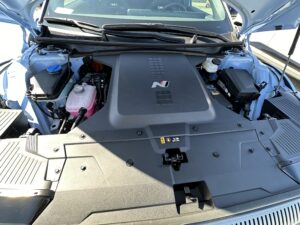
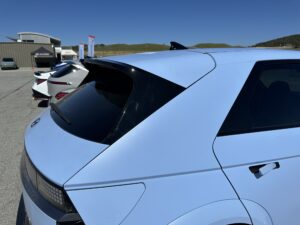
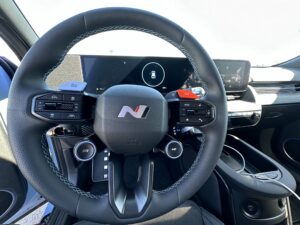
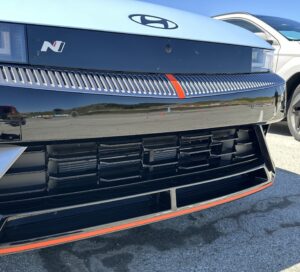

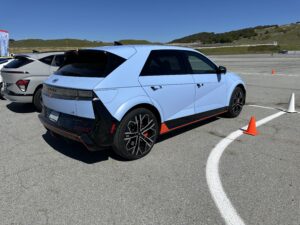

Leave a Reply